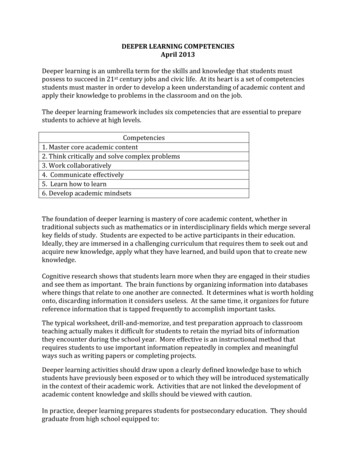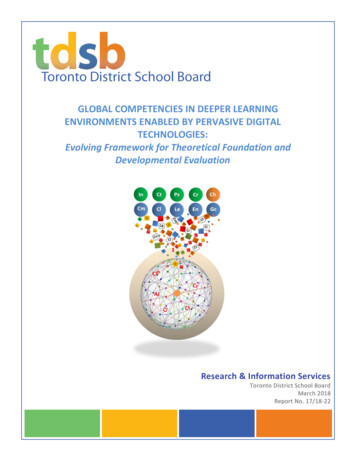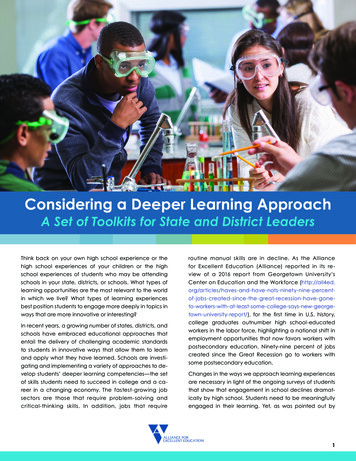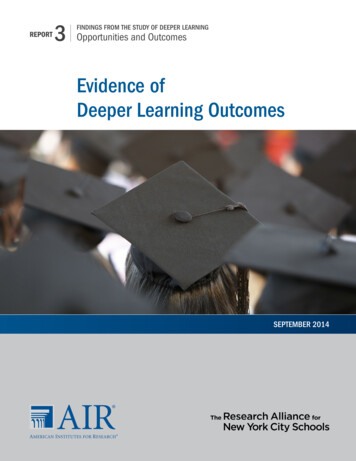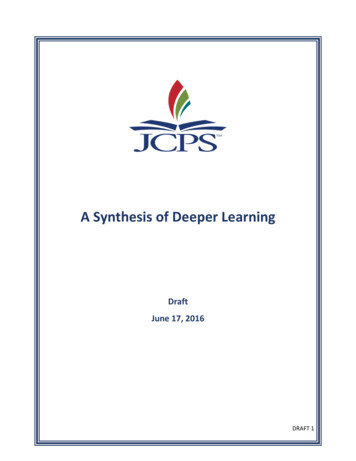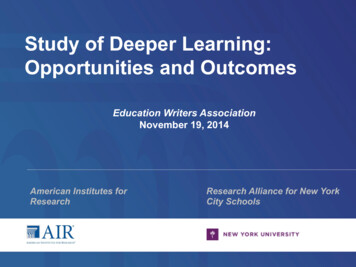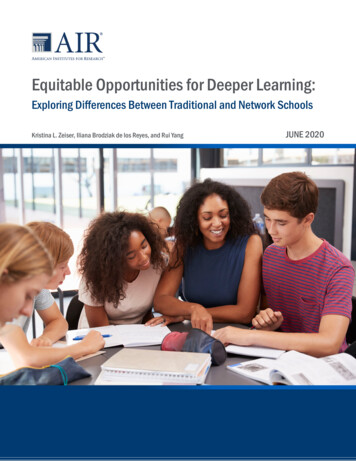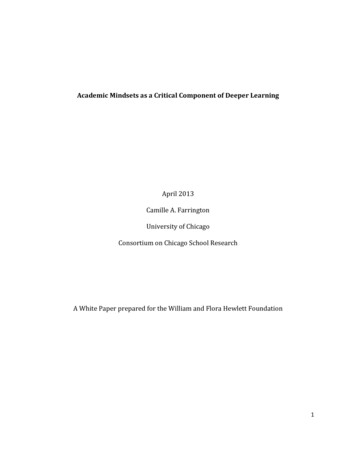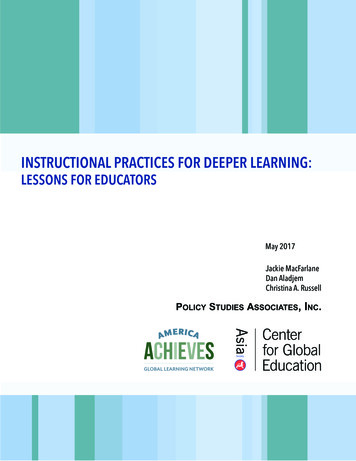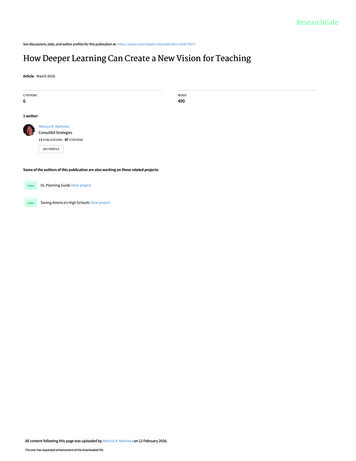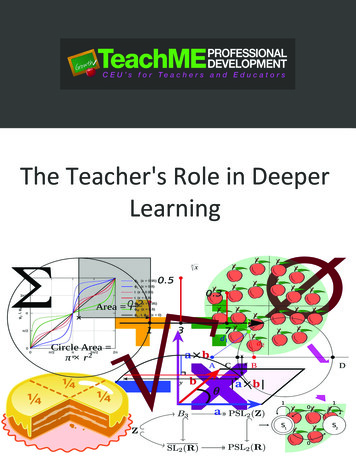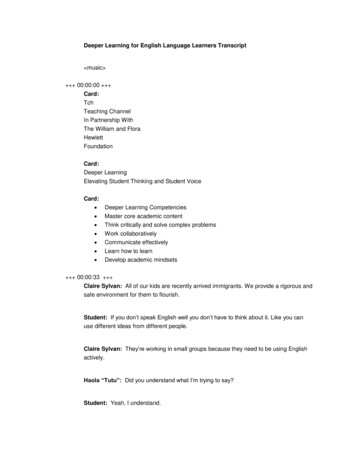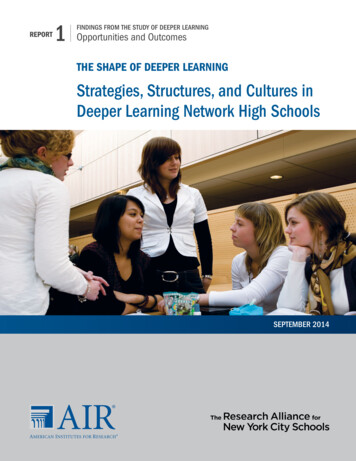
Transcription
REPORT1FINDINGS FROM THE STUDY OF DEEPER LEARNINGOpportunities and OutcomesTHE SHAPE OF DEEPER LEARNINGStrategies, Structures, and Cultures inDeeper Learning Network High SchoolsSEPTEMBER 2014
AcknowledgmentsThe authors would like to acknowledge themany people who helped make this studypossible. We thank the thousands of students,teachers, principals, network and districtstaff who agreed to provide responses to thestudy’s many data collections. We extend ourappreciation to the William and Flora HewlettFoundation for the grant that made this studypossible, and particularly to Kristi Kimball forher initiation of the project and to Marc Chunand Barbara Chow for their consistent supportthroughout the research process. Our thanksalso go to Kerstin Carlson Le Floch and LauraSalganik at AIR for their careful technical reviewand to Emma Ruckley for her thorough editing.We are also grateful to Jim Kemple and thestaff at the Research Alliance for New YorkCity Schools for their expert analysis in thiscollaboration. The statements, findings, andconclusions here are those of the authorsand study leads and do not necessarilyrepresent the viewpoint of these organizationsor individuals.Funded byThe William and Flora Hewlett FoundationNote: The content of this report is identical tothe original report released in September 2014.Only the report design has been modified.
REPORT 1FINDINGS FROM THE STUDY OF DEEPER LEARNINGOpportunities and OutcomesTHE SHAPE OF DEEPER LEARNINGStrategies, Structures, and Cultures inDeeper Learning Network High SchoolsSEPTEMBER 2014AuthorsMette Huberman, Catherine Bitter, Jennifer Anthony, Jennifer O’DayAmerican Institutes for ResearchProject DirectorJames Taylor, American Institutes for ResearchPrincipal InvestigatorsJennifer O’Day, American Institutes for ResearchMichael S. Garet, American Institutes for ResearchStudy TeamJarah BlumLeah BrownMegan BrownMichele CadiganConnie ChandraSuzette ChavezPorsche CoxHelen DuffyMarian EatonPatrice FabelRachel GarrettAlison HauserAngela HsuMelissa HunterAlex KistnerDiana Mercado-GarciaJohn MezzanotteJordan RicklesJamie ShkolnikAllison WatersKristina ZeiserTara ZuberMichael SegeritzMolly AlterJames Kemple
ContentsAbstract . . . . . . . . . . . . . . . . . . . . . . . . . . . . . . . . . . . . . . . . . . . . . . . . . . . . . . . . . . . . . . . . viIntroduction . . . . . . . . . . . . . . . . . . . . . . . . . . . . . . . . . . . . . . . . . . . . . . . . . . . . . . . . . . . . . .1What Is Deeper Learning and Why Is it Important? . . . . . . . . . . . . . . . . . . . . . . . . . . . . . . . .Assumptions Underpinning the Deeper Learning Initiative . . . . . . . . . . . . . . . . . . . . . . . . . .The Study of Deeper Learning: Opportunities and Outcomes . . . . . . . . . . . . . . . . . . . . . . . .The Focus of This Report . . . . . . . . . . . . . . . . . . . . . . . . . . . . . . . . . . . . . . . . . . . . . . . . . .Strategies to Promote Deeper Learning in Network Schools . . . . . . . . . . . . . . . . . . . . . . . . . . .9Cognitive Domain: Strategies to Promote Mastery of Core Academic Content and CriticalThinking Skills . . . . . . . . . . . . . . . . . . . . . . . . . . . . . . . . . . . . . . . . . . . . . . . . . . . . . . . . .Cognitive Domain: Main Findings . . . . . . . . . . . . . . . . . . . . . . . . . . . . . . . . . . . . . . . .Cognitive Development Goals . . . . . . . . . . . . . . . . . . . . . . . . . . . . . . . . . . . . . . . . . . .Developing a Deeper Learning Curriculum . . . . . . . . . . . . . . . . . . . . . . . . . . . . . . . . . .Deeper Learning Instructional Strategies . . . . . . . . . . . . . . . . . . . . . . . . . . . . . . . . . . .Assessing for Deep Content Knowledge . . . . . . . . . . . . . . . . . . . . . . . . . . . . . . . . . . .Interpersonal Domain: Strategies to Develop Communication and Collaboration Skills . . . . .Interpersonal Domain: Main Findings . . . . . . . . . . . . . . . . . . . . . . . . . . . . . . . . . . . . .Communication and Collaboration Goals . . . . . . . . . . . . . . . . . . . . . . . . . . . . . . . . . . .Instructional Activities: Collaborative Group Work and Internships . . . . . . . . . . . . . . . . .Assessments: Presentations and Exhibitions . . . . . . . . . . . . . . . . . . . . . . . . . . . . . . . .Intrapersonal Domain: Strategies to Develop Academic Mindsets and Learning-to-LearnCompetencies . . . . . . . . . . . . . . . . . . . . . . . . . . . . . . . . . . . . . . . . . . . . . . . . . . . . . . . .Intrapersonal Domain: Main Findings . . . . . . . . . . . . . . . . . . . . . . . . . . . . . . . . . . . . .Academic Mindsets and Learning-to-Learn Goals . . . . . . . . . . . . . . . . . . . . . . . . . . . . .Instruction: Individualized Learning . . . . . . . . . . . . . . . . . . . . . . . . . . . . . . . . . . . . . . .School Structures and Cultures to Facilitate Deeper Learning .School Structures and Cultures: Main Findings . . . . . . . . . . . . . . . . . . . . . . . . . . . . . . . . .Advisory Classes . . . . . . . . . . . . . . . . . . . . . . . . . . . . . . . . . . . . . . . . . . . . . . . . . . . . . .Alternative and Flexible Scheduling . . . . . . . . . . . . . . . . . . . . . . . . . . . . . . . . . . . . . . . . . .Personalized School Cultures . . . . . . . . . . . . . . . . . . . . . . . . . . . . . . . . . . . . . . . . . . . . . .Differences Between Network and Non-Network Schools .Differences Between Schools: Main Findings . . . . . . . . . . . . . . . . . . . . . . . . . . . . . . . . . .Cognitive Domain . . . . . . . . . . . . . . . . . . . . . . . . . . . . . . . . . . . . . . . . . . . . . . . . . . . . . .Interpersonal and Intrapersonal Domains . . . . . . . . . . . . . . . . . . . . . . . . . . . . . . . . . . . . .School Structures and Cultures . . . . . . . . . . . . . . . . . . . . . . . . . . . . . . . . . . . . . . . . . . . .Conclusion . . . . . . . . . . . . . . . . . . . . . . . . . . . . . . . . . . . . . . . . . . . . . . . . . . . . . . . . . . . . . .35References . . . . . . . . . . . . . . . . . . . . . . . . . . . . . . . . . . . . . . . . . . . . . . . . . . . . . . . . . . . . . .38
AbstractThe Study of Deeper Learning: Opportunities and Outcomes—funded by the William and Flora Hewlett Foundation—is a proof-of-conceptstudy, the purpose of which was to determine whether students attending high schools with a mature and at least moderately wellimplemented approach to promoting deeper learning actually experienced greater deeper learning opportunities and outcomes thanwould have been likely had they not attended these schools. In this report—our first in a series of three—we provide a picture of thestrategies and supporting structures in our study sample of schools.This analysis focuses on the strategies implemented in 19 high schools across 10 school networks participating in the Foundation’sDeeper Learning Community of Practice. We also include some comparative information collected from 11 comparison high schools.While we collected a wide range of data for this study, the analysis in this first report relies primarily on qualitative data from interviewsand focus groups with school administrators, teachers, students, and network leaders and support providers, supplemented with relevantdata from a survey of teachers in both network and comparison schools.Key findings include the following:1. Across the three deeper learning domains, sampled network schools used a range of strategies to develop deeper learningcompetencies—most commonly project-based learning, internship opportunities, collaborative group work, and longer termcumulative assessments. In the cognitive domain, all but one network school (18 of 19) employed project-based learning (PBL) to some degree todevelop mastery of core academic content knowledge and critical thinking skills. PBL was integral to daily instruction inslightly over a third of these schools and used more sporadically in others. Also in the cognitive domain, three quarters of the network schools (14 of 19) provided connections to the real world throughinternship opportunities for students. At two schools, internships were considered central to learning and occurred two orthree days per week across all four years. The remaining 12 schools incorporated internships for a portion of students atsome point in their school career to provide career-related experience, boost life skills, or help with the transition from highschool to college and careers. In the interpersonal domain, collaboration and communication skill development was an explicit goal reported by staff at amajority of network schools (11 of 19), which they addressed through collaborative group work and longer term assessments(such as portfolios and exhibitions, where students had to present and defend their work). In the intrapersonal domain, almost half of the network schools (9 of 19) reported having explicit goals related to intrapersonalcompetencies (learning how to learn and academic mindsets) for students and they used a variety of strategies to encouragethe development of these skills, including study groups and student participation in decision making. Three schools focusedon individualized learning as a way to develop independent learning and self-management skills.2. Most network schools supported the implementation of instructional approaches aligned with deeper learning throughthe development of specific structural and cultural elements, including advisory classes (16 schools), alternative scheduling(14 schools), and personalized learning environments (all schools). However, these structures and cultures looked different acrossthe schools. For example, advisory classes had different numbers of students (from 15 to 30 students), ran for different amountsof time (between 30 and 60 minutes), and happened with different frequencies (from every day to once or twice a week),depending on the school.3. Comparisons between the network and non-network school principal interview data suggest that the network schoolsemployed strategies to foster the deeper learning competencies to a greater extent than did the non-network schools,particularly in the areas of project-based learning, internship opportunities, collaborative group work, longer term cumulativeassessments, and development of intrapersonal skills. Network schools also employed advisory classes and alternative schedulingto a higher degree than the non-network schools.viREPORT 1 FINDINGS FROM THE STUDY OF DEEPER LEARNING Opportunities and Outcomes
IntroductionIn the past few years, a veritable movement for “deeper learning” has emerged on the UnitedStates’ educational scene, based on decades of development work by educators, support fromthe philanthropic community, and the interest and engagement of national and local policymakers.This is the first in a series of three research reports on the strategies, opportunities, and outcomesof a set of high schools explicitly organized to promote deeper learning among their students. Inthis introductory section, we discuss the concept of deeper learning, describe the study’s approach,and outline the focus of this report.What Is Deeper Learning and Why Is it Important?Failure of the No Child Left Behind Act (2001) to produce the levels of proficiency and collegepreparedness anticipated by its authors has sparked considerable discussion and debate in thepast six years about what today’s students really need to know and be able to do to be successfulboth in school and in their lives and work after graduation. Much of the policy focus has been onthe need for students to develop deeper content knowledge and an ability to apply their knowledgeand skills to novel tasks and situations inside and outside of school (Alliance for ExcellentEducation, 2011). The recently developed Common Core State Standards (CCSS) in EnglishLanguage Arts (ELA) and mathematics and the Next Generation Science Standards reflect thisdual focus on high levels of academic learning and real-world application.Yet many of even the staunchest supporters of the new standards believe that the goals ofeducation must reach further. For decades, it has been recognized that academic knowledge andskills are themselves insufficient for enabling students to successfully navigate a rapidly changingworld, participate in a complex and increasingly diverse democracy, and engage fully in the everevolving 21st century workplace. Students also need to be able to communicate their ideasthrough a variety of media and to a variety of audiences, work together with others to solveproblems, think creatively, and manage their own learning (Autor, Levy, & Murnane, 2003;National Research Council [NRC], 2008; Carnevale & Desrochers, 2003). They need to developdispositions—or mindsets—that empower them to confront new challenges, take initiative, andpersevere through difficulties and setbacks (Dweck, 2006; Finegold & Notabartolo, 2010). Takentogether, this combination of a deeper understanding of core academic content, an ability to applythat understanding to novel problems and situations, and a range of competencies related tohuman interaction and self-management has been encapsulated under the term “deeper learning” ineducation policy and reform circles.Deeper learning as a goal for students is an evolving concept, the dimensions of which are labeledand described in varying ways. Based on extensive interviews with experts in the field and a reviewof the relevant literature, the William and Flora Hewlett Foundation identified six dimensions of1THE SHAPE OF DEEPER LEARNING Strategies, Structures, and Cultures in Deeper Learning Network High Schools
deeper learning, which have collectively become the focus of a national initiative to promotedeeper learning in schools. These dimensions are: Mastery of core academic content Critical thinking and problem solving Effective communication Ability to work collaboratively Learning how to learn Academic mindsets (William and Flora Hewlett Foundation, 2013; Chow, 2010; Trilling, 2010).Taking a slightly different approach, a recent review of theory and research across an array ofdisciplines led a National Research Council panel (NRC, 2012) to define deeper learning as “theprocess through which an individual becomes capable of taking what was learned in one situationand applying it to new situations (i.e., transfer).” The panel distinguished this process from thespecific “21st century competencies” it produces. The NRC grouped these competencies intothree domains: the cognitive domain, the interpersonal domain, and the intrapersonal domain.These domains subsume neatly the six dimensions identified by the Hewlett Foundation, providinga compatible framework for the purposes of both research and practice.Competencies Associated With Deeper Learning (Hewlett Foundation and NRC Frameworks)Cognitive DomainDeep content knowledgeCritical thinking and complex problem solvingInterpersonal DomainCollaborationCommunicationIntrapersonal DomainLearning-to-learn competenciesAcademic mindsetsAssumptions Underpinning the Deeper Learning InitiativeThe concept of deeper learning has gained momentum among educators and policymakers as ameans of better preparing students for college and career. Underlying this movement are severalfundamental assumptions relating educational approaches to desired student outcomes:1. Educators can design/redesign schools’ instructional strategies, structures, and culturesto explicitly focus on deeper learning; the strategies, structures, and cultures may takedifferent forms in different schools, but they will be collectively distinct from more traditionaleducational approaches, particularly at the high school level.2REPORT 1 FINDINGS FROM THE STUDY OF DEEPER LEARNING Opportunities and Outcomes
2. Students in schools thus designed—including those from traditionally underservedgroups—will experience greater opportunities to engage in deeper learning than theywould have otherwise.3. These opportunities, in turn, will lead to transferable competencies needed for successin college, career, and civic life.At its most basic, the theory of action for this reform direction might be depicted as follows:This report focuses on the first of these assumptions—that is, it describes the approaches thata group of schools with a focus on deeper learning have taken, including the instructional goalsand strategies they have put in place and the structures and cultures designed to support thesestrategies. (Subsequent reports in this series will address the other two assumptions.)The Study of Deeper Learning: Opportunities and OutcomesWhile political and educational interest in deeper learning has grown considerably in just a fewyears, the research base has lagged behind and to date has provided only weak empirical supportfor the assumptions above. Early evaluation studies of schools participating in deeper learningfocused networks suggested positive effects, but they had a number of limitations relating to theirresearch design, samples, data, measures, or analyses (Yuan & Le, 2010). More recent evaluations(Collins et al., 2013; Guha et al., 2014; Nichols-Barrer & Haimson, 2013) indicate positive programeffects on indicators such as grade point average (GPA), progress to graduation, and state testresults, but these studies are either primarily descriptive in nature or have focused on demonstratingthe effectiveness of specific instructional programs or strategies aligned with the goals of deeperlearning. In its review of the literature, the previously cited NRC panel noted the limitations ofexisting (primarily correlational) research in establishing linkages between 21st century/deeperlearning competencies and long-term outcomes for students, recommending that foundations andfederal agencies support further research in this arena (NRC, 2012). As a result of this limitedempirical base, there has recently been increased interest in rigorous research that evaluateswhether approaches focused on deeper learning—which take many forms in practice—areassociated with improved educational experiences and outcomes for students from all backgrounds.The Study of Deeper Learning: Opportunities and Outcomes—funded by the Hewlett Foundation—aimed to determine whether students who attended high schools with a mature and at least3THE SHAPE OF DEEPER LEARNING Strategies, Structures, and Cultures in Deeper Learning Network High Schools
moderately well implemented approach to promoting deeper learning actually experienced greaterdeeper learning opportunities and outcomes than would likely have been the case had they notattended these schools. In contrast to an evaluation of a particular program or instructionalstrategy, this proof-of-concept study focused on providing evidence about whether schools canpromote deeper learning across a variety of reasonably well implemented approaches and adiversity of students. The research team aimed to address the evidence gap related to deeperlearning by using a rigorous quasi-experimental design1 to examine a set of high schools (hereafterreferred to as “network” schools) associated with 10 established networks from across thecountry that embrace the goals of deeper learning, promote instructional practices they believeare likely to lead to deeper learning competencies, and participate in the Hewlett Foundation’sDeeper Learning Community of Practice. To examine whether students in these high schoolsexperienced improved opportunities for deeper learning and greater outcomes than they wouldhave in other schools, we also included students from a se
employed strategies to foster the deeper learning competencies to a greater extent than did the non-network schools, particularly in the areas of project-based learning, internship opportunities, collaborative group work, longer term cumulative assessments, and development of intrapersonal skills.File Size: 831KB
